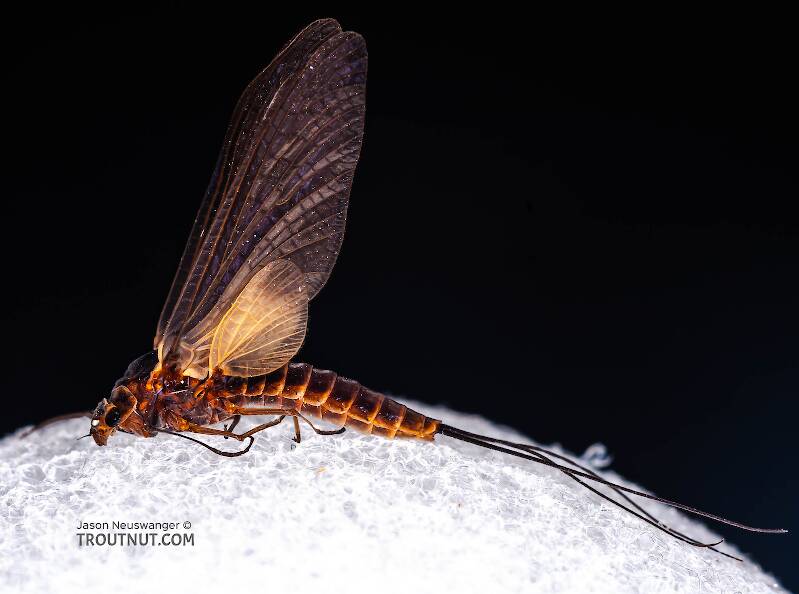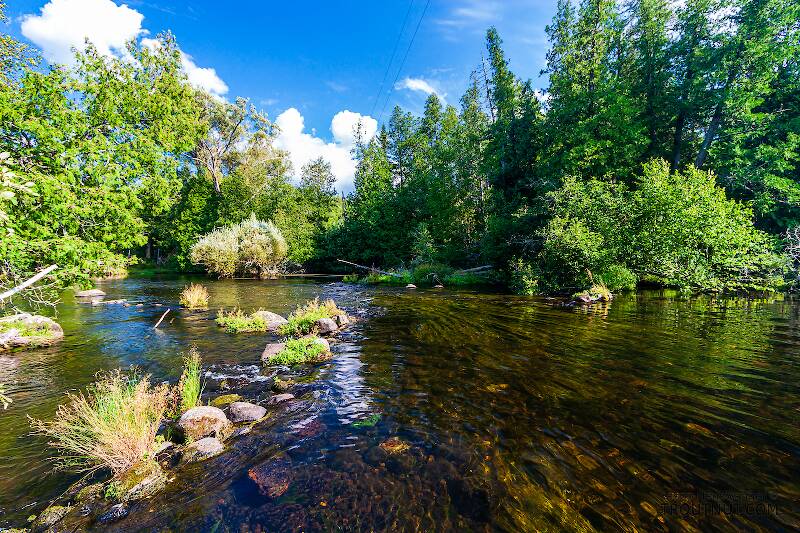
Salmonflies
Pteronarcys californica
The giant Salmonflies of the Western mountains are legendary for their proclivity to elicit consistent dry-fly action and ferocious strikes.
Featured on the forum

It's only barely visible in one of my pictures, but I confirmed under the microscope that this one has a prosternal horn and the antennae are mid-way between the eyes and front of the head capsule.
I'm calling this one Pycnopsyche, but it's a bit perplexing. It seems to key definitively to at least Couplet 8 of the Key to Genera of Limnephilidae Larvae. That narrows it down to three genera, and the case seems wrong for the other two. The case looks right for Pycnopsyche, and it fits one of the key characteristics: "Abdominal sternum II without chloride epithelium and abdominal segment IX with only single seta on each side of dorsal sclerite." However, the characteristic "metanotal sa1 sclerites not fused, although often contiguous" does not seem to fit well. Those sclerites sure look fused to me, although I can make out a thin groove in the touching halves in the anterior half under the microscope. Perhaps this is a regional variation.
The only species of Pycnopsyche documented in Washington state is Pycnopsyche guttifera, and the colors and markings around the head of this specimen seem to match very well a specimen of that species from Massachusetts on Bugguide. So I am placing it in that species for now.
Whatever species this is, I photographed another specimen of seemingly the same species from the same spot a couple months later.
I'm calling this one Pycnopsyche, but it's a bit perplexing. It seems to key definitively to at least Couplet 8 of the Key to Genera of Limnephilidae Larvae. That narrows it down to three genera, and the case seems wrong for the other two. The case looks right for Pycnopsyche, and it fits one of the key characteristics: "Abdominal sternum II without chloride epithelium and abdominal segment IX with only single seta on each side of dorsal sclerite." However, the characteristic "metanotal sa1 sclerites not fused, although often contiguous" does not seem to fit well. Those sclerites sure look fused to me, although I can make out a thin groove in the touching halves in the anterior half under the microscope. Perhaps this is a regional variation.
The only species of Pycnopsyche documented in Washington state is Pycnopsyche guttifera, and the colors and markings around the head of this specimen seem to match very well a specimen of that species from Massachusetts on Bugguide. So I am placing it in that species for now.
Whatever species this is, I photographed another specimen of seemingly the same species from the same spot a couple months later.

Troutnut is a project started in 2003 by salmonid ecologist Jason "Troutnut" Neuswanger to help anglers and
fly tyers unabashedly embrace the entomological side of the sport. Learn more about Troutnut or
support the project for an enhanced experience here.

I collected this mayfly after user Al514 tipped me off to the presence of some Leptophlebia mayflies I didn't seem to have yet with his ID request of a male dun. This seems to be of the same species. I also collected a female spinner. Based on that spinner, I can tell that this is either Leptophlebia cupida or Leptophlebia nebulosa, but I can't tell which.
Unfortunately none of the specimens I collected made it through the hot, sunny day very well. So the pictures aren't great, but they're better than nothing.
Unfortunately none of the specimens I collected made it through the hot, sunny day very well. So the pictures aren't great, but they're better than nothing.
Oldredbarn on May 10, 2010May 10th, 2010, 4:04 am EDT
I will apologise up front here for railing on about another "Michigan" thing, but here goes...There is a rather famous fly from the Au Sable area originally put together by Ernie Borchers called the Borchers Drake and it was designed to cover this bug. Originally the abdomen was wrapped condor quill but wrapped natural turkey tail fibers are used now. The tail is three moose mane fibers tied longer than normal and on these specimens of Jason's you can see why that works. It's tied in a Catskill style or as a parachute pattern. Hackle is Adams style and the wing is light blue dun...Have at it!
Spence
Spence
"Even when my best efforts fail it's a satisfying challenge, and that, after all, is the essence of fly fishing." -Chauncy Lively
"Envy not the man who lives beside the river, but the man the river flows through." Joseph T Heywood
"Envy not the man who lives beside the river, but the man the river flows through." Joseph T Heywood
TNEAL on May 13, 2010May 13th, 2010, 2:02 am EDT
Charlie Kroll, Fred Bear's son-in-law and a man who, according to him, has "fished on all the best rivers in the world", told me years ago that the Borcher's Special was the single best dry fly he ever used... this coming from a guy who caught brown trout in excess of 16 pounds and brook trout over 10 pounds on a fly. Needless to say, that got my attention.
TNEAL on May 13, 2010May 13th, 2010, 2:06 am EDT
This is an addendum to my last post re the Borcher's Special...
It appears that this fly is an excellent imitation of any darker colored mayfly... guids use ti regularly in sizes 14-18 for our early season Hendricksons and Little Mahoganies... trout over 20" are regularly taken on #14's during the Hendrickson hatch.. bigger sizes are excellent when Isonychias begin..
I have added one slight variation to this fly which makes it even more effective..
Tim Neal
It appears that this fly is an excellent imitation of any darker colored mayfly... guids use ti regularly in sizes 14-18 for our early season Hendricksons and Little Mahoganies... trout over 20" are regularly taken on #14's during the Hendrickson hatch.. bigger sizes are excellent when Isonychias begin..
I have added one slight variation to this fly which makes it even more effective..
Tim Neal
TNEAL on May 13, 2010May 13th, 2010, 2:08 am EDT
This is an addendum to my last post re the Borcher's Special...
It appears that this fly is an excellent imitation of any darker colored mayfly... guides use it regularly in sizes 14-18 for our early season Hendricksons and Little Mahoganies... trout over 20" are regularly taken on #14's during the Hendrickson hatch.. bigger sizes are excellent when Isonychias begin..
I have added one slight variation to this fly which makes it even more effective..
Tim Neal
It appears that this fly is an excellent imitation of any darker colored mayfly... guides use it regularly in sizes 14-18 for our early season Hendricksons and Little Mahoganies... trout over 20" are regularly taken on #14's during the Hendrickson hatch.. bigger sizes are excellent when Isonychias begin..
I have added one slight variation to this fly which makes it even more effective..
Tim Neal
Quick Reply
Related Discussions
Topic
Replies
Last Reply
0
Dec 21, 2009
by Oldredbarn
by Oldredbarn


